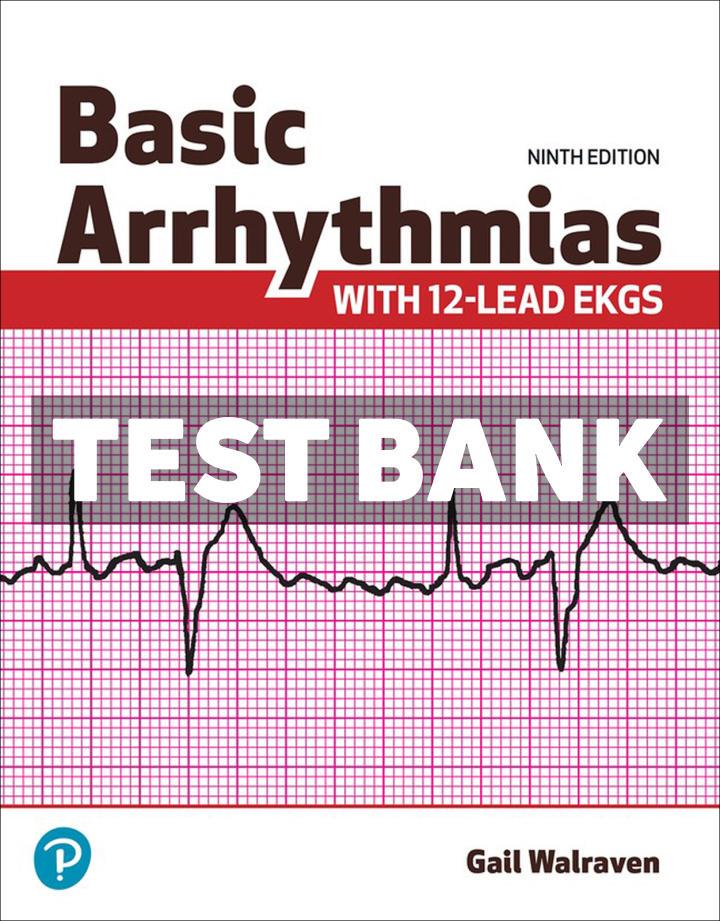
Basic Arrhythmias With 12-Lead EKGs, 9e (Walraven)
Chapter 1 Electrophysiology
1) The inherent rate of the SA node is ________ bpm.
A) 30-60
B) 40-60
C) 60-100
D) 100-120 Answer: C
Learning Obj.: 1.3
2) The inherent rate of the AV junction is ________ bpm.
A) 20-40
B) 40-60
C) 60-100
D) 100-120 Answer: B
Learning Obj.: 1.3
3) The inherent rate of the ventricle is ________ bpm.
A) 20-40
B) 40-60
C) 60-100
D) 100-120 Answer: A
Learning Obj.: 1.3
4) The built-in rate of each of the three major areas of the conduction system is referred to as the ________ rate.
A) fast
B) heart
C) escape
D) inherent Answer: D
Learning Obj.: 1.3
5) What term is used to refer to the process of electrical discharge and the flow of electrical activity?
A) Repolarization
B) Depolarization
C) Polarization
D) Polarized Answer: B
Learning Obj.: 1.2
6) If polarizing is considered the ready state, then ________ would be considered the recovery state.
A) discharge
B) polarization
C) repolarization
D) depolarization
Answer: C
Learning Obj.: 1.2
7) After leaving the area of the AV node, impulses go through the ________ to reach the right and left bundle branches.
A) Purkinje fibers
B) Bundle of His
C) AV junction
D) SA node
Answer: B
Learning Obj.: 1.3
8) Part of the parasympathetic branch of the autonomic nervous system is the ________ nerve.
A) vagus
B) coronary
C) aortic
D) pericardial
Answer: A
Learning Obj.: 1.4
9) When stimulated, the ________ branch of the nervous system increases heart rate, AV conduction, and irritability.
A) parasympathetic
B) sympathetic
C) pacemaker
D) inherent
Answer: B
Learning Obj.: 1.4
10) Which cardiac cells are responsible for initiating and conducting pacemaker impulses?
A) Motor cells
B) Mechanical cells
C) Electrical cells
D) Atrioventricular cells
Answer: C
Learning Obj.: 1.1
11) Which is the normal pacemaker of the heart?
A) SA node
B) AV node
C) AV junction
D) Ventricle
Answer: A
Learning Obj.: 1.3
12) Which of the following is NOT a part of the normal cardiac conduction system?
A) Coronary sinus
B) AV node
C) Purkinje Fibers
D) Internodal pathways
Answer: A
Learning Obj.: 1.1
13) What is the term for the fail-safe mechanism that allows a lower pacemaker to take over when a higher site fails?
A) Polarization
B) Irritability
C) AV conduction
D) Escape
Answer: D
Learning Obj.: 1.4
14) Which of the following best explains the mechanism called irritability?
A) The ventricles repolarize before they are ready.
B) The normal pacemaker slows down and gives up control.
C) A lower pacemaker site speeds up to take control of the heart.
D) The normal pacemaker changes its inherent rate.
Answer: C
Learning Obj.: 1.4
15) Which of the following does NOT happen when the sympathetic branch is stimulated?
A) Heart rate increases.
B) The heart becomes more irritable.
C) Impulses go faster through the AV node.
D) Ventricular conduction slows down.
Answer: D
Learning Obj.: 1.4
